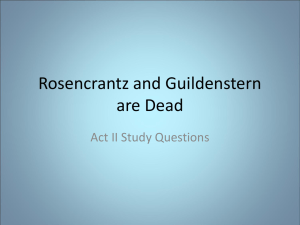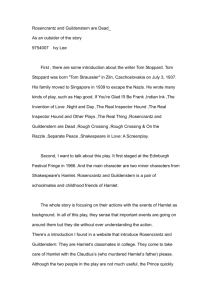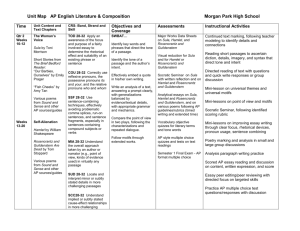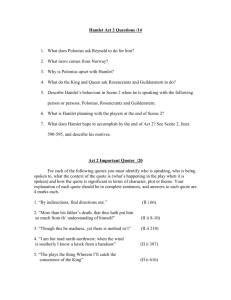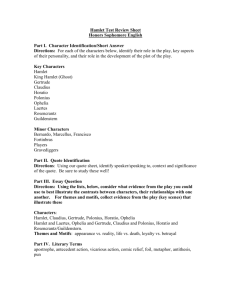Rosencrantz and Guildenstern Are Dead
advertisement
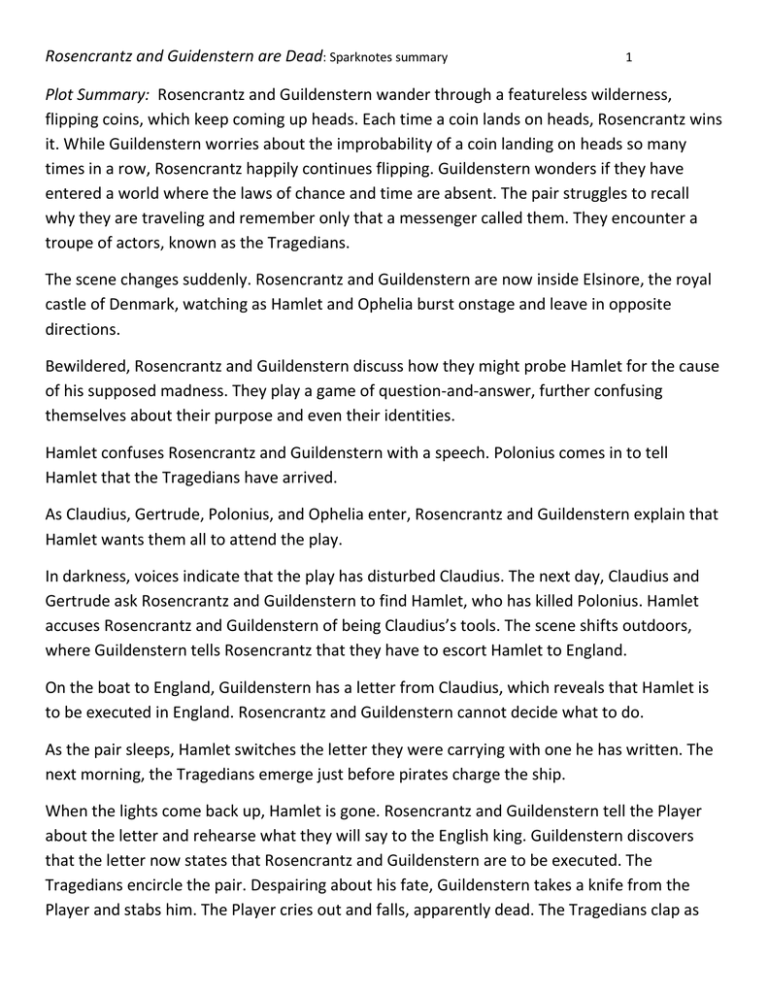
Rosencrantz and Guidenstern are Dead: Sparknotes summary 1 Plot Summary: Rosencrantz and Guildenstern wander through a featureless wilderness, flipping coins, which keep coming up heads. Each time a coin lands on heads, Rosencrantz wins it. While Guildenstern worries about the improbability of a coin landing on heads so many times in a row, Rosencrantz happily continues flipping. Guildenstern wonders if they have entered a world where the laws of chance and time are absent. The pair struggles to recall why they are traveling and remember only that a messenger called them. They encounter a troupe of actors, known as the Tragedians. The scene changes suddenly. Rosencrantz and Guildenstern are now inside Elsinore, the royal castle of Denmark, watching as Hamlet and Ophelia burst onstage and leave in opposite directions. Bewildered, Rosencrantz and Guildenstern discuss how they might probe Hamlet for the cause of his supposed madness. They play a game of question-and-answer, further confusing themselves about their purpose and even their identities. Hamlet confuses Rosencrantz and Guildenstern with a speech. Polonius comes in to tell Hamlet that the Tragedians have arrived. As Claudius, Gertrude, Polonius, and Ophelia enter, Rosencrantz and Guildenstern explain that Hamlet wants them all to attend the play. In darkness, voices indicate that the play has disturbed Claudius. The next day, Claudius and Gertrude ask Rosencrantz and Guildenstern to find Hamlet, who has killed Polonius. Hamlet accuses Rosencrantz and Guildenstern of being Claudius’s tools. The scene shifts outdoors, where Guildenstern tells Rosencrantz that they have to escort Hamlet to England. On the boat to England, Guildenstern has a letter from Claudius, which reveals that Hamlet is to be executed in England. Rosencrantz and Guildenstern cannot decide what to do. As the pair sleeps, Hamlet switches the letter they were carrying with one he has written. The next morning, the Tragedians emerge just before pirates charge the ship. When the lights come back up, Hamlet is gone. Rosencrantz and Guildenstern tell the Player about the letter and rehearse what they will say to the English king. Guildenstern discovers that the letter now states that Rosencrantz and Guildenstern are to be executed. The Tragedians encircle the pair. Despairing about his fate, Guildenstern takes a knife from the Player and stabs him. The Player cries out and falls, apparently dead. The Tragedians clap as Rosencrantz and Guidenstern are Dead: Sparknotes summary 2 the Player jumps up. He says that his death was a mediocre performance while showing Guildenstern that the knife was actually a stage prop. The Player describes the different deaths that his troupe can perform while the Tragedians act out those deaths onstage. Rosencrantz applauds, and the light shifts, leaving Rosencrantz and Guildenstern – they are to be hanged. ________________________Themes ___________________________________ The Incomprehensibility of the World Rosencrantz and Guildenstern Are Dead highlights the fundamental mystery of the world. Rosencrantz and Guildenstern spend the entirety of the play in total confusion, lacking such basic information as their own identities. From the play’s opening, which depicts them as unable to remember where they are headed and how they began their journey, to their very last moments, in which they are bewildered by their imminent deaths, Rosencrantz and Guildenstern cannot understand the world around them. Their confusion stems from both the sheer randomness of the universe, illustrated by the bizarre coin-tossing episode, and the ambiguous and unclear motives of the other characters, who pop onstage and deliver brief, perplexing speeches before quickly exiting. The Difficulty of Making Meaningful Choices The constant confusion in which they find themselves leaves Rosencrantz and Guildenstern feeling unable to make any significant choices in their lives. They are pushed along toward their deaths by what appear to be random forces, and they fail to respond to their circumstances with anything but total passivity. The Relationship Between Life and the Stage Rosencrantz and Guildenstern Are Dead emphasizes the close connection between real life and the world of theatrical performance. Within the play, the connection between life and the stage is revealed to Rosencrantz and Guildenstern by the presence of the Tragedians, who perform a play that depicts parallel events to those in which the two men find themselves. This play shows that the characters most similar to Rosencrantz and Guildenstern are ultimately killed, which is precisely the fate that befalls Stoppard’s main characters. Rosencrantz and Guidenstern are Dead: Sparknotes summary 3 Guildenstern criticizes the Player for assuming that theatrical performance can depict real feelings, especially the terror of death. The Player’s response is twofold—he claims that theatrical death is the only kind people believe in because it is what they expect, and then he demonstrates that point to Rosencrantz and Guildenstern by convincingly performing his own death when Guildenstern stabs him with a stage knife. Rosencrantz and Guildenstern Are Dead includes many of Hamlet’s most notable scenes in a way that casts them in a new light. For instance, the most famous portion of Hamlet is the “To be or not to be” soliloquy, Hamlet’s monologue about mortality and whether he should kill himself. Stoppard includes this scene, but it occurs in the background, while Rosencrantz and Guildenstern, in the foreground, wonder whether to approach Hamlet. As Hamlet mulls over his death, they decide that the time is perfect for a casual chat. This belief is deeply at odds with Hamlet’s actual state of mind, which the audience knows but the characters do not. Such dramatic irony is funny, but it serves a larger purpose. Hamlet is regarded as one the greatest works of world literature, but Stoppard’s comic treatment of it shows the importance of viewing Hamlet on its own terms rather than as the apex of literary tradition. By presenting Hamlet not as a great artifact but as a play that depicts real feelings and complex characters, Stoppard reminds his audience of the power of Shakespeare’s play to speak to us on an individual, human level. The Game of Questions The game of questions is like a tennis match, back and forth between two players, where each player must ask a question and then answer a question with another question. Scoring is the same as in tennis. Rules: no statements, no repetition, no hesitation, no synonyms, no rhetoric (philosophical ideas) and no non-sequitors (random ideas that don’t connect to the previous ideas). Do you want to play questions? How do you play that? You have to ask a question. Statement. One - Love. Cheating. How? I haven't started yet. Statement. Two - Love. Are you counting that? What? Are you counting that? Foul. No repetition. Three - Love and game. I'm not going to play if you're going to be like that. Who's serve? Uh... Rosencrantz and Guidenstern are Dead: Sparknotes summary Hesitation. Love - One. Who's go? Why? Why not? What for? HA. No synonyms. One all. What in God's name is going on? Foul. No rhetoric. Two - One. What does it all add up to? Can't you guess? Are you addressing me? Is there anyone else? Who? How would I know? Why do you ask? Are you serious? Was that rhetoric? No. Statement. Two all. Game point. What's the matter with you today? When? What? Are you deaf? Am I dead? Yes or no? Is there a choice? Is there a God? Foul. No non-sequiturs. Three - Two. What's your name? What's yours? You first. Statement. One - Love. What's your name when you're at home? What's yours? When I'm at home? Is it different at home? What home? Haven't you got one? Why do you ask? What are you driving at? What's your name? Repetition. Two - Love. Match point. Who do you think you are? Rhetoric. Game and match! One game all. 4
